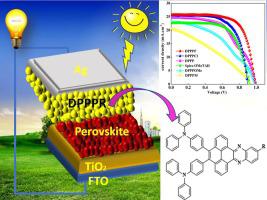Solar Energy ( IF 6.0 ) Pub Date : 2021-09-03 , DOI: 10.1016/j.solener.2021.08.055 Gurulakshmi Maddala , Ramesh Gade , Jakeer Ahemed , Susmitha Kalvapalli , Narendra Babu Simhachalam , Prabhakar Chetti , Someshwar Pola , Raghavender Mitty

|
The present work demonstrates, a new type of phenazine core-based hole transporting materials (HTMs) were synthesized and tested for improved power conversion efficiency via enhanced short-circuit density (Jsc) of 25.80 mA/cm2, which is much higher as compared with Spiro-OMeTAD benchmark material in perovskite solar cells (PSCs). All the synthesized new phenazine core-based HTMs were thoroughly characterized with various spectroscopic techniques. The strong electron-donating triphenylamine (D) and electron-accepting phenazine (A) units communicate through a pyrene system (π) with large intramolecular charge transfer (ICT) character in these HTMs and hence no requirement of additional dopants or additives throughout the device fabrication process. The framework of the PSCs device, FTO\meso-TiO2\CH3NH3PbI3\new-HTMs\Ag, was assembled through new HTMs such as DPPP, DPPPCl, DPPPF, DPPPM and DPPPOMe and Methylammonium lead iodide (CH3NH3PbI3) as materials. PSCs with DPPPF and Spiro-OMeTAD HTMs, revealed power conversion efficiency (PCE) of 18.20% and 17.57% with an active area of 3.02 and 2.16 cm2 respectively. The stability of the devices was examined after 60 days, and found the PCE of 17.48% for DPPPF based device, whereas spiro-OMeTAD based device revealed PCE of 8.34%. Furthermore, the present study demonstrates DPPP series HTMs as possible replacements to the Spiro-OMeTAD, owing to their very simple synthesis process and dopant-free conditions, and their better device performance.
中文翻译:

用于高性能钙钛矿太阳能电池的高效、无掺杂吩嗪基空穴传输材料
目前的工作表明,合成并测试了一种新型吩嗪核基空穴传输材料 (HTM),以通过提高25.80 mA/cm 2的短路密度 (J sc )来提高功率转换效率。,与钙钛矿太阳能电池(PSC)中的 Spiro-OMeTAD 基准材料相比要高得多。所有合成的新型吩嗪核 HTM 都用各种光谱技术进行了彻底的表征。强给电子三苯胺 (D) 和受电子吩嗪 (A) 单元通过芘系统 (π) 进行通信,在这些 HTM 中具有大分子内电荷转移 (ICT) 特性,因此不需要在整个器件中添加额外的掺杂剂或添加剂制作过程。一个PSC装置的框架,FTO \内消旋的TiO 2 \ CH 3 NH 3碘化铅3 \新HTMS \的Ag,通过新HTMS如DPPP,DPPPCl,DPPPF,DPPPM和DPPPOMe和甲基铵碘化铅组装(CH 3NH 3 PbI 3 ) 作为材料。具有 DPPPF 和 Spiro-OMeTAD HTM 的 PSC 显示功率转换效率 (PCE) 为 18.20% 和 17.57%,有效面积分别为 3.02 和 2.16 cm 2。60 天后检查设备的稳定性,发现基于 DPPPF 的设备的 PCE 为 17.48%,而基于 spiro-OMeTAD 的设备显示 PCE 为 8.34%。此外,本研究表明 DPPP 系列 HTM 可作为 Spiro-OMeTAD 的替代品,因为它们的合成过程非常简单,无掺杂条件,并且具有更好的器件性能。











































 京公网安备 11010802027423号
京公网安备 11010802027423号